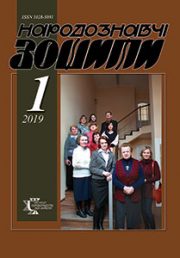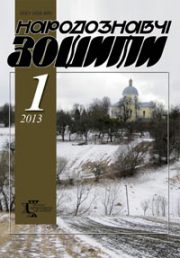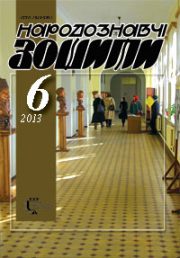The Ethnology Notebooks. 2021. № 3 (159), 659—665
UDK 392.5(477.46-21=161.2)”18/20″:930.85
DOI https://doi.org/10.15407/nz2021.03.659
THE RITE «WEDDING BRANCH» (ACCORDING TO THE MATERIALS OF THE HISTORICAL UMAN REGION)
YOVENKO Larysa
- ORCID ID: https://orcid.org/0000-0003-1035-071X
- Doctor of Pedagogical Sciences,
- Associate Professor of Ukrainian Literature,
- Ukrainian Studies and Teaching Methods
- Department Pavlo Tychyna Uman State
- Pedagogical University
- 2, Garden street, 20300, Uman, Tcherkasy area, Ukraine,
- Contacts: e-mail: yovenko310@ukr.net
TERESHKO Іnna
- ORCID ID: https://orcid.org/0000-0002-5682-7766
- Candidate of Pedagogical Sciences,
- Associate Professor of Choreography and
- Artistic Culture Department Pavlo Tychyna
- Uman State Pedagogical University
- 2, Garden street, 20300, Uman, Tcherkasy area, Ukraine,
- Contacts: e-mail: art_dekanat@meta.ua
Abstract. The urgency of the topic lies in the need to form a new personality as a patriot of Ukraine, based on national traditions, customs, rituals, folklore heritage, art and more. This reinforces the need to create appropriate conditions for the promotion of national cultural heritage, past and present of the Ukrainian nation. The relevance of the article is also due to insufficient study of folklore and ethnographic material of the historical Uman region. Therefore, the aim of the article is to study the ritual and mythological essence of the «branch» rite, to present the peculiarities of its existence in the historical Uman region at the end of the XIX — beginning of the XXI century. The object of research is the «wedding branch» ceremony. Subject — local and territorial features of this rite in the historical Uman region.
The methodological basis of the research is used by culturological and chronological-historical (to understand evolution and transformation due to «writing a wedding cow»), expedition method (to study its local-territorial features), as well as the method of theoretical generalization. The novelty of the work in the generalization of local and territorial features due to the «wedding branch», published samples of ceremonial wedding folklore of the historical Uman region. Conclusions. Thus, the studied rite has a deep archaic meaning. It is established that it reflects: 1) the cult of the sun, fertility; 2) connection with nature, flora, native land; 3) the cult of the family.
The study of scientific works, archival materials of the research laboratory «Problems of training future teachers of philology for Ukrainian studies at school» (Uman State Pedagogical University named after Pavlo Tychyna) showed that the rite of «department» in the villages of historical Uman retains authentic features, has a kind of script ritual which is manifested in the fixed local and territorial features of its implementation. This rite is still an important part of the wedding ceremony of Uman region.
Careful study of regional forms of folklore in the educational process of higher education has significant potential in promoting the cultural heritage of the native ethnic group, fostering respect for the material and spiritual heritage of Ukrainian and other peoples.
Keywords: wedding ceremony, wedding branch, wedding folklore, Uman, historical region, national cultural heritage.
Received 20.04.2021
REFERENCES
- (1999, june 19). Joint Declaration of the Ministers of Education of Europe «European Higher Education Area». Retrieved from: https://zakon.rada.gov.ua/laws/show/en/994_525#Text [in Ukrainian]
- New Ukrainian school. Conceptual principles of secondary school reform. Retrieved from: https://mon.gov.ua/ua/tag/nova-ukrainska-shkola [in Ukrainian].
- (2014, july 1). On Higher Education. Official web-portal of the Parliament of Ukraine. Retrieved from: http://zakon2.rada.gov.ua/laws/show/1556-18 [in Ukrainian].
- Vovk, H. (1995). Studies in Ukrainian ethnography and anthropology. Kyiv: Art [in Ukrainian].
- Sumtsov, N. (1996). Symbolism of Slavic rites: Selected works. Moscow: Eastern Literature [in Russian].
- Yashchurzhinsky, H. (1880). Lyrical Little Rusynian songs, mostly wedding. Warsaw: Typography of M. Zemkevich and V. Noakovsky [in Russian].
- Brizhko, M. (1919). Wedding in the town of Dubova, Uman district, Kyiv region. Materials on Ukrainian Ethnology (Vol. XIX—XX, pp. 63—66) [in Ukrainian].
- Ganyuchenko, Z. (1919). Wedding in the village of Gordashivtsi, Uman County, Kyiv Region. Materials on Ukrainian Ethnology (Vol. XIX—XX, pp. 33—51) [in Ukrainian].
- Sivachuk, N. (2010). Uman wedding. Uman: ALMI [in Ukrainian].
- Yovenko, L. (2010). Folklore and ethnographic heritage of the village of Gorodetske, Uman district, Cherkasy region. Uman: ALMI [in Ukrainian].
- Yovenko, L., & Tereshko, I. (2013). Folklore and ethnographic heritage of the village of Cherpovody, Uman district, Cherkasy region. Uman: PP Zhovtyy [in Ukrainian]
- Semenchuk, V. (2014). Folklore of the village of Rohy, Uman district, Cherkasy region. Uman: PP Zhovtyy [in Ukrainian].
- Tereshko, I., & Yovenko, L. (2012). Folklore and ethnographic heritage of the village of Tymoshivka, Mankiv district, Cherkasy region. Uman: PP Zhovtyy [in Ukrainian].
- Osipenko, N., & Goncharuk, V. (2019). Folklore heritage of the village of Pugachivka, Uman district, Cherkasy region. Uman: ALMI [in Ukrainian].
- Maksimovich, M. (1977). Collection of works (Vol. 2). Kyiv: MP Fritz Printing House [in Russian].
- Semenchuk, O. Oksanina, Uman district, Cherkasy region, recorded from Tkachenko Teklia Tikhinivna, born in 1930, June 10, 1999. In Archive of the research laboratory «Problems of preparation of future teachers of philology for Ukrainian studies work at school». F. 97. Op. 7. Od. sb. 24. Ark. 132 [in Ukrainian].
- Sivachuk, N. (2011). Kupala rituals of Uman region. Uman: PP Zhovtyy [in Ukrainian].
- Nowosielski, A. (1857). People of Ukraine (Vol. I—II). Vilnius: Glucksberg [in Polish].
- Karavelov, L. (1861). Monuments of folk life of Bulgarians (Book I). Moscow: K. Anders Printing House [in Russian].
- Buslaev, F. (1851). Epic poetry. Article one. Domestic Notes, 7 [in Russian].
- Voitovych, V. (2002). Ukrainian mythology. Kyiv: Lybid [in Ukrainian].
- Zhayvoronok, V. (2006). Signs of Ukrainian ethnoculture: Dictionary-reference book. Kyiv: Dovira [in Ukrainian].
- Gut, N. Legedzyne, Talnivskyi district, Cherkasy region, recorded from Kryzhanivska Marusya, born in 1928 and Drobot Parasky, born in 1927, 6.07.2004. In Archive of the research laboratory «Problems of preparation of future teachers of philology for Ukrainian studies work at school». F. 1. Op. 3. Od. sp. 236. Ark. 17 [in Ukrainian].
- Gaishuk, T. Korzhova Sloboda, Uman district, Cherkasy region, recorded from Shevchenko Maria Korniivna, born in 1921, 12.06.2001. In Archive of the research laboratory «Problems of preparation of future teachers of philology for Ukrainian studies work at school». F. 177. Op. 4. Od. sp. 145. Ark. 65 [in Ukrainian].







